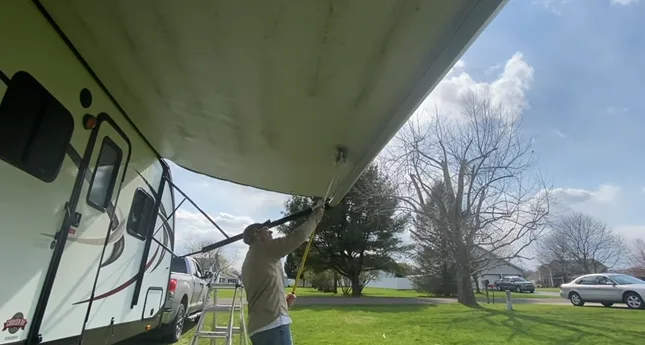Last Updated on April 20, 2023
An RV awning’s humid, dark environment makes it an ideal place for mold and mildew to grow. Irrespective of how thoroughly you clean your RV awning, mold and mildew always seem to find a way to make themselves at home.
Awnings on RVs are highly susceptible to mold and mildew. In severe cases, they may cause the awning to deteriorate and discolor. Not only unsightly but can shorten your awning’s lifespan. As mold and mildew produce spores in the air, they may pose a health risk.
This is why it is crucial to understand how to keep RV awning from molding for both the awning’s longevity and the safety of those using them. By following a few simple steps, you can prevent your retractable awning from becoming moldy.
We will discuss each of these steps in detail throughout this article.
How to Keep RV Awning from Molding : Some Easy Steps
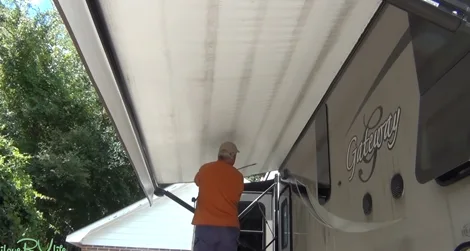
Anyone who has ever owned an RV knows that they require extra care and RV awning maintenance. One of the most important things to keep in mind is the need to prevent mold and mildew growth.
RV awnings are particularly susceptible to molding, as they are constantly exposed to moisture. Consider these simple steps on how to prevent mold on RV awning:
Step 01. Open & Lower Your Awning:
If you want to safeguard your awning from molding, the first step is to open and lower it regularly. This will allow you to inspect the awning for any signs of mold or mildew and clean it if necessary.
The air will circulate through the awning when it is opened, which helps to keep it dry. If you’re leaving your RV for an extended time, be sure to open and lower the awning regularly.
Step 02. Know Your Awning Fabric:
Most awnings are made from acrylic or vinyl. Awnings made from acrylic are not waterproof, but they usually dry within a few hours of becoming wet. That’s why acrylic awning is more resistant to mold and mildew, but it’s also more expensive.
But if you have a vinyl awning fabric, make sure to clean it regularly with a mold and mildew-resistant cleaner. The vinyl awnings are mildew resistant but not mildew proof. So, if you live in an area with high humidity, you may want to consider adding a dehumidifier to your RV.
Step 03. Get Your Cleaning Solution Ready:
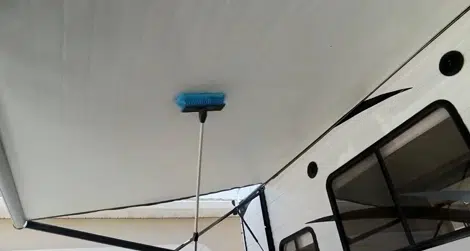
To begin cleaning your awning and prevent mold, you must gather a few supplies. You need to gather your best RV awning cleaner solution. A gentle cleaner is best, as you don’t want to damage the fabric.
Many different types of cleaners can be used to clean an RV awning. It is possible to use a standard store-bought cleaner (like Valterra’s RV awning cleaner, or Camco awning cleaner) or, using bleach, dish soap, and water; you can make your awning cleaning solution.
RVers also recommend the following methods:
- Turpentine
- Peanut butter
- Isopropyl alcohol (Highly recommended)
- An all-purpose cleaner (like Clorox Clean-Up spray, Formula 409)
Step 04. Clean Your RV Awning:
Once you have gathered your supplies, it’s time to start awning cleaning. The best way to clean your awning is to use a soft brush or sponge and wipe the awning in a circular motion.
Rinse the awning thoroughly with clean water. Clean the awning arms and roller tube with a soft bristle brush and mild soap. If you see any areas that are particularly dirty or moldy, you can use a harder brush to scrub those areas.
Be sure to rinse the awning thoroughly when you’re done with a pressure washer or hose.
Step 05. Dry Your RV Awning:
Drying your RV awning is essential to preventing mold growth. Once you have cleaned your awning, it’s essential to dry it thoroughly. The best way to do this is to open the awning and let it air dry in the sun.
After every rainstorm or wash, or period of heavy humidity, open up your awning and allow it to air out for several hours. If possible, prop up the awning with sticks or poles to enhance airflow. It is also possible to place a fan underneath the awning to help speed up the drying process.
Make sure to remove any debris that might be trapping moisture against the fabric, such as leaves or twigs, that might be trapping moisture against the fabric. You can avoid the growth of mold and mildew on your RV awning by following these simple steps.
What Factors Can Cause Molding on RV Awning?
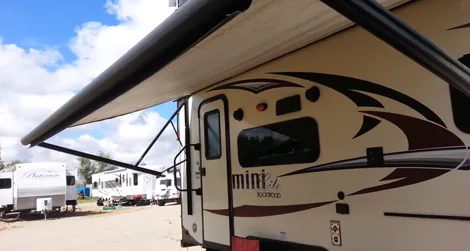
Mold is a type of fungi that naturally occurs in the environment and can be found indoors and outdoors. While mold is necessary for decomposing organic matter, it It may also create health problems for humans, particularly those with allergies or asthma.
Several different factors may cause an RV awning to mold. As we know, mold and mildew need three key things to grow: moisture, darkness, and warmth but other factors can also play a role in mold growth.
Some of the most common factors that often contribute to molding in an RV awning include:
Awnings Rolled Up for Lengthy Periods:
Leaving the awning rolled up for a prolonged period of time is a leading cause of molding. If you leave your awning rolled up for extended periods, it can trap moisture against the fabric and lead to mold growth.
This would create the perfect environment for mold spores to take hold, as the fabric will be damp and shady.
Storing the RV in a Humid Environment:
Excess moisture is the primary cause of mold and mildew growth on RV awnings. If you store your RV in a humid climate, it’s essential to take steps to limit the amount of moisture that comes into contact with the fabric awning.
For example, you can open windows and vent fans when showering or cooking to help circulate air and reduce moisture levels. You should also avoid allowing wet clothing or towels to contact the fabric awnings.
If possible, try to raise the awning during periods of high humidity to allow air to circulate underneath.
Poor Ventilation in the RV:
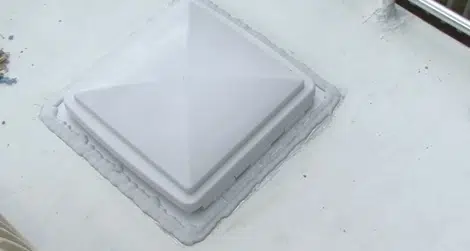
When there is little to no air circulation inside the RV, the humidity level rises and causes condensation. This moisture condenses on the coolest surfaces first, which are often the windows, walls, and ceilings.
If this condensation is not promptly removed, it will lead to mold growth. Poor ventilation can also cause musty odors and promote the growth of dust mites.
Leaving Damp Items on the Awning:
When water evaporates, it leaves behind minerals that can accumulate on the awning fabric and facilitate mildew and mold growth. Additionally, damp items can block sunlight and air circulation, which also increases the chances of mold growth.
Damp objects left on awnings can encourage mold to thrive. These wet items catch moisture and prevent the awning from drying correctly, fostering mold growth. If you think that mold might be growing on your awning, it’s important to take action immediately.
Failure to Clean the Awning Properly:
Dirty awnings are one of the common causes of molding in RV awnings. If you don’t clean your awning regularly, dirt and debris can build up on the fabric, making it an ideal breeding ground for mold spores.
Over time, mold growth can cause the fabric to deteriorate, making it more susceptible to tearing and other damage.
As part of regular awning maintenance, be sure to inspect your awning for signs of mold growth as soon as you notice them so you can take action to prevent further damage.
Material that is Not Mold-Resistant:
Another problem with molding in awnings is the use of materials that are not mold-resistant. Certain types of fabric support mold growth. As a result, it’s important to choose an awning material made from a resistant awning material to mold and mildew.
These factors can be present in your RV awning if you’re not careful. So you need to be more conscious to avoid these factors and keep your structure free from mold.
Tips for Maintaining Your RV Awnings from Molding
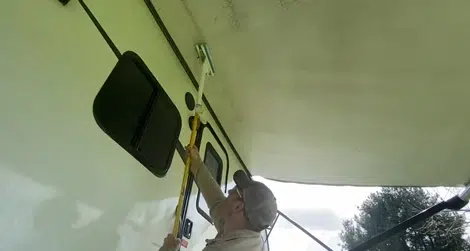
RV awnings are a great addition to any rig, providing much-needed shade and protection from the elements. However, they can also be a magnet for mold and mildew if they’re not properly cared for. As anyone who has RVed ever knows, there is a lot of equipment that needs to be taken care of, and the awning is no exception. Here are a few tips for keeping your RV awnings in tip-top shape:
01. Be Careful When Selecting the Fabric:
The fabric you choose for your RV awning will affect how easy it is to keep clean. Some fabrics are more susceptible to mold and mildew than others. If you live in an area with high humidity, it’s imperative to choose a breathable fabric that won’t trap moisture.
There are a variety of breathable fabrics available, like cotton or synthetic blends, that are treated with chemicals that resist mold and mildew, so be sure to opt for these options when making your purchase.
02. Inspect the Awning Regularly:
Inspecting your RV awning regularly is one of the best ways to prevent mold and mildew buildup. Take a close look for any damp or discolored areas, as these are prime breeding grounds for mold spores. If you see any signs of mold, be sure to clean it up immediately.
You should also Inspect the awning fabric itself for any signs of wear or tear. If the fabric is damaged, it will be more susceptible to mold growth. By regularly inspecting your awning, you can nip mold problems in the bud and keep your RV looking its best.
03. Clean the Awning Regularly:
Cleaning your RV awning frequently is one of the best ways to prevent mold and mildew growth. A simple solution of soap and water can be used to remove most dirt and grime. Using a more powerful cleaning solution may be necessary for tougher stains. Bleach can be used for white or light-colored awnings, but it should be diluted with water.
For stubborn stains, you can also try using a power washer. Just be sure to hold the water hose nozzle at least 12 inches from the fabric to avoid damaging it. If you clean your awning regularly, you’ll be able to enjoy it for many years to come.
04. Roll it Up Properly When Not Using:
When you’re not using your RV awnings, roll them up properly. This will prevent molding and keep them in good condition. Make sure the awnings are dry before rolling them up. If they’re wet, they could mold. Roll the awnings from the bottom up, so that any water drips off the top.
Store the awnings in a dry, cool place when you’re not using them. Check them periodically for mold or mildew and clean them with a solution of bleach and water if necessary.
05. Keep Your Awnings Dry:
Keep your RV awnings dry to prevent mold from growing. This may seem obvious, but it’s often overlooked. Awnings are designed to protect you from the elements, so they should be water-resistant. However, even the most durable awnings can succumb to mold and mildew if they’re left damp for too long.
That’s why it’s so crucial to take them down and allow them to dry thoroughly after each use. If you live in an area with high humidity, you may also want to invest in a dehumidifier for your RV. By keeping your awnings dry, you’ll help prevent mold and mildew growth.
06. Do Not Leave the Awnings Exposed:
One of the people’s biggest mistakes is leaving their awnings exposed to the elements during the off-season. To prevent mold growth on your RV awnings, it is advisable not to leave them exposed. Exposed awnings are more likely to mold, leading to fabric degradation and awning damage. Moreover, they will also be more likely to fade and become brittle.
To help prevent these problems, make sure to store your awnings in a dry, shaded area when they are not in use. You can also purchase a cover for your awning to protect it from the elements.
07. Store the Awning Properly:
Maintaining your RV awnings is vital to extend their lifespan and prevent mold, wear and tear. One tip for doing this is to store the awning properly after use. This means keeping it clean, dry, and free from debris or dirt.
You should also make sure that the awning is rolled up correctly to avoid creases or wrinkles. If you take care of your awning, it will last longer and protect your awning for years to come.
These tips are just a few things you can do to keep your RV awning in good condition and give you some information on how to prevent mildew on RV awning.
FAQs
Let’s take a look at some of the most frequently asked questions about RV awnings to help you better understand how to remove mildew from RV awning & take care of them:
Q: How Often Should I Clean My RV Awning to Prevent Mold Growing?
Generally, you should service your RV awning at least once a year. This helps prevent dirt and grime from building up, which can eventually stop mold from growing. For best results, clean your awning after every trip. This will help ensure that it’s in good condition for the next camping season.
Q: Do Vinegars Kill Mold on Rv Awnings?
White vinegar is a popular choice for killing mold and mildew because it is acidic. This means that it can effectively kill 80% of mold species. You can clean your awning with vinegar by mixing equal parts water and vinegar in a spray bottle. Let the solution sit for a few minutes before wiping it away with a damp cloth.
Q: Will a Dehumidifier Help with Mold?
Absolutely, a dehumidifier can help prevent mold growth by reducing the amount of moisture in the air. This is especially important in rooms prone to dampness, such as basements or laundry rooms.
Q: What Level of Humidity Kills Mold?
Mold needs water to grow, so keeping the humidity below 50% of your RV awning will help prevent it from growing. However, if there is already mold present, you will need to get the humidity below 35% to kill it. You can use a hygrometer to measure the humidity in your RV.
Conclusion
RV awnings are a great way to provide shade and protection for your vehicle while camping. But over time, they can become damaged if they’re not properly maintained. The awning may develop mold if you store the RV in a dark and humid place.
For RV awnings to remain in tip-top condition, it’s good to know how to keep RV awning from molding by cleaning them regularly and storing them properly when they aren’t in use. By following those simple tips, you can maintain your RV awning and extend its life. Hopefully, you now have all the information you need to keep your awning looking great.

